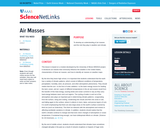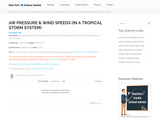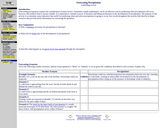
Students learn about air masses and the role they play in weather and climate.
- Subject:
- Earth Science
- Science
- Material Type:
- Lesson Plan
- Provider:
- American Association for the Advancement of Science
- Author:
- AAAS
- Date Added:
- 02/26/2019

Students learn about air masses and the role they play in weather and climate.

Students will graph data to better understand the relationship of low pressure to storm severity.

This tutorial by Bill Nye explains how to make a simple barometer using a jar and a balloon. The barometer is an old and accurate first look at predicting the weather by examining the pressure of the atmosphere. Students will discover how atmospheric pressure and surface gravity help meteorologists forecast the weather.

In this tutorial students will learn about water in the atmosphere. Students will learn about cloud types, cloud formation, humidity and dewpoint, and much more.

In this activity series students will learn more about global, regional, and local weather (and climate) drivers. This particular activity focuses on clouds, ways that the ocean and atmosphere combine to move moisture and heat energy around the globe, and wind and pressure.

In this activity students will learn about air masses, fronts, pressure systems, and wind patterns in relation to regional weather.

In this tutorial students will learn about the four major types of air masses and how they create fronts that affect weather patterns.

In this tutorial students will learn how to interpret weather maps and understand weather forecasting.

In this tutorial students will investigate different types of weather phenomena (lightning, tornadoes, hurricanes, blizzards and floods). Students will also relate unequal heating of land and water surfaces to form large global wind systems and weather events such as tornados and thunderstorms

In this unit students will learn about specific dangers of storms and hurricane hazards. Students will also look at safety precautions.

In this unit students will learn about specific dangers of storms and hurricane hazards. Students will also look at safety precautions.

In this unit students will learn about specific dangers of storms and hurricane hazards. Students will also look at safety precautions.

Students collect weather data over several days or weeks, graph temperature data, and compare the temperature data collected with long-term climate averages from where they live. Understanding the difference between weather and climate and interpreting local weather data are important first steps to understanding larger-scale global climate changes.

This tutorial provides information about El Nino - its early warning signs, its ancient past, its global connections, and its impacts on the globe.

In this unit, students will develop an understanding of climate change and how it is different from climate variability. Students will read articles and access data, maps, and graphs of trends. They will also view several short video clips and learn about and compare climate models. Students will see how climate impacts life and life impacts climate in both short and long timescales.

In this lab, students will get a better sense of how rapidly the most recent—century-scale—changes in global temperature are taking place as compared to past—millennial-scale—changes. They will gain a better understanding of the interrelationship between global temperatures and atmospheric concentrations of the greenhouse gases, especially carbon dioxide. Students will also view satellite maps showing the spatial patterns of global warming over the past 150 years.

This activity allows students to track hurricane data using coordinates.

The purpose of this online tutorial activity is to introduce some indicators that useful for predicting when and where precipitation is going to occur. Key words throughout this activity link directly to helper resources that provide useful information for answering the questions.

The purpose of this online tutorial activity is to explore these factors in greater detail and investigate their possible outcomes on forecasted temperatures. Key words throughout this activity link directly to helper resources that provide useful information for answering the questions.

The activities in this guide will help students understand variations in environmental parameters by examining connections among different phenomena measured on local, regional, and global scales.